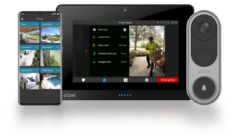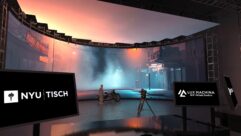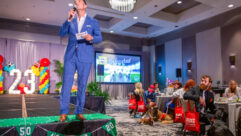A Great View Of The Action
The high-definition video and audio systems in Ringers Sports Lounge ensure that patrons never miss a play.
Mapping the spaceHigh-definition videoAudio support
CHALLENGE: Convert a 7,500-square-foot warehouse into a high- tech sports lounge equipped with state-of-the-art sound and video systems.
SOLUTION: Install 24 high-definition video displays accompanied by ambient sensing sound reinforcement and wireless Internet capability to cater to patrons’ needs from every seat in the house.
HOUSED IN the historic warehouse district of Austin, TX, Ringers Sports Lounge has recently become the place in town to meet with friends, enjoy a meal or drinks, and catch all the latest sports action. Opened in September 2004, the 100-year-old building is equipped with a wealth of high-definition video displays, an ambient noise sensing audio system, lighting, HVAC, and security — all under automated control.
The space was previously home to a music club and the facility’s new owners wanted to minimize the downtime necessary to transform the venue into its new identity as a sports lounge. Austin, TX-based systems design and integration firm Next was tasked with creating the AV blueprint for the space. “The facility was gutted, designed, and re-opened in just three months,” says Dan McLaughlin, president of Next.
The owners wanted Ringers to be a high-end sports bar that offered high-quality video from any location within the space. “My main goal was to dazzle people when they walked through the door,” says Ringers’ General Partner Bob Gillett. “In order to keep my guests’ attention, I knew I had to have better video than what most people have in their living rooms — particularly when sports was concerned.”
Ambient Noise Sensing Solution
The Biamp Nexia CS contains an ambient noise compensator (ANC), which was used to make automatic level adjustments to Ringers’ house audio system. To use this feature, the Next integration team placed two Shure SM-58 microphones in the ceiling area — one each for the front and rear halves (two zones) of the patron’s area — for detecting changes to the room’s noise level.
“Through a process of considerable trial and error, we ultimately arrived at four settings that work well for the space,” McLaughlin says. Those settings include Open (quiet business hours), Lunch (moderate business activity), Dinner (peak evening business hours), and Close (system mute/all quiet).
White noise was used to approximate the room’s ambient noise levels during initial setup, and after opening, additional measurements were taken using actual patrons as a noise source. For each setting, the audio system was configured for operation at 20 dB above each of the four setting thresholds.
The Nexia’s primary system settings (and those used for system configuration) include minimum and maximum gain, setting response time, setting threshold, and gain ratio. The Nexia system can also minimize the control dialog boxes to create custom user control surfaces. For this system to operate correctly, the Nexia system must be the last block in the program signal path, with no form of level control provided at the outputs, amplifiers, or loudspeakers.
Because the lounge’s physical space is relatively long and narrow (45 feet by 167 feet), the floor plan provides for a dramatic, J-shaped bar counter that spans the majority of the patrons’ area. The counter is angled diagonally across the center of the venue, with the bar’s curvature greeting guests toward the front entrance. A series of booths spans the left wall, while the rest of the facilities are positioned on the opposite side of the room. Tables occupy the remaining open areas at both ends of the bar. With this floor plan, the bar and its range of video displays serves as the focal point of the space, with the front right and rear walls providing additional surface areas for the venue’s two largest video displays.
“Determining the sight lines within the space was quite a challenge,” says Tim Cuppett, Austin, TX-based architect and interior designer for the project. “The theme for this venue is all about sports action. The owners wanted high-definition video all the time — everything else is subordinate to that. The goal was to display and position all the screens in such a manner as to achieve the most impact and visibility from every seat in the house.”
To accommodate guests at the front, rear, and side areas, 11 NEC PX50XM4A 50-inch plasma displays and nine NEC PX42VR4A 42-inch plasmas — each suspended from the A-pitched ceiling using custom cut, black painted pipe — are positioned at various viewing angles. When the lights go down in the evening hours, the displays, which are attached to support pipes using a combination of Chief display mounts and custom fabricated bracketing, appear to float in air. All wiring runs through the pipe and is hidden from view.
Ringers’ owners originally expressed cost concerns about plasma burn-in and failure rates on individual screen elements. To address these issues, McLaughlin conducted extensive research, and selected the NEC PX Series plasma displays for their three-year warranty and 60,000-hour half-life, which is how equipment is rated for use in 24/7 commercial environments. “At the time of this installation, the NECs had, by far, the best warranty offering and longevity rating in the industry,” McLaughlin says.
Bracketing Ringers on the front right and rear walls are the venue’s two largest HD displays. A Stewart Filmscreen 135-inch diagonal, 16:9 aspect ratio GrayHawk screen is mounted on the rear wall, while the largest display in the house is a 160-inch diagonal, 16:9 aspect ratio display surface created with Goo Systems’ Screen Goo, a specially formatted, highly reflective acrylic paint designed for video projection. Ceiling-mounted NEC GT6000 dual lamp projectors offering 6,000 ANSI lumens provide images for both screens.
Projection Surface on a Budget
With the overwhelming amount of their equipment procurement budget invested in plasma displays, audio, and system control equipment, the AV integration team needed to find a high-quality, yet cost-effective means for creating a 160-inch diagonal 16:9 projection surface for the front side wall at Ringers. They found the solution to their challenge in Goo Systems’ Screen Goo.
Screen Goo is a specially formatted, highly reflective acrylic paint, designed specifically for the video projection industry. Suitable for both commercial and residential installations, this acrylic paint transforms any smooth, paintable surface into a projection screen. Screen Goo formulations are available in CRT white, digital grey, or digital grey lite topcoats and CRT white and digital grey basecoats (which are required for the topcoats).
“Our projection surface is actually a sheetrock wall that we framed with wood trim and painted with Screen Goo, a two-part paint process,” says Dan McLaughlin, president of Next, the Austin, TX-based systems design and integration firm tasked with the project. “For roughly $500, we were able to construct a screen that, when viewed, you’d swear cost $4,000.”
During the day the projectors typically run in economy mode (3,000 ANSI lumens), but the units are switched to run both lamps (6,000 ANSI lumens) to project a more vivid image as business picks up in the evening. “All of this is handled via the AMX NI-3000 NetLinx integrated controller,” McLaughlin says. “We have the system programmed to switch over to dual mode in the evenings, and we also created a ‘game’ button on both the AMX NTX-CV12 12-inch video touch-panel and the AMX MVP-8400 8.4-inch Modero ViewPoint wireless touchpanel for manual selection in the event of an important program during the daytime.” The AMX system also controls the house lighting, audio, and security.
Source material comes from a combination of high-definition satellite and cable receivers and a single Marantz PMD970 DVD player. All video sources are routed by an AutoPatch Modula Series high-bandwidth component switcher, which can route as many as 16 sources to any of Ringers’ 24 destinations. Source RCA component video feeds are routed to RGB terminals on the AutoPatch Modula and are then wired directly to the displays as 1080i high-definition component video. The only exceptions to this arrangement are a downconverted signal for the video preview capability handled by the AMX NTX-CV12 touchpanel and the DVD player.
Typically, a manager will preview program selections on the AMX touchpanel prior to routing that signal to any desired display or combination of displays. Ringers also subscribes to several custom sports programming channels, taking full advantage of the system’s flexibility. “With the NFL’s Sunday Ticket programming package, it’s amazing how much football can be viewed in this facility,” McLaughlin says. “They can easily show 10 different programs running simultaneously.”
And to ensure that patrons never miss a piece of the action at Ringers, the facility’s AV support even continues into the men’s and women’s restrooms where Zenith L20V36 20-inch LCD video monitors are located behind two-way mirrors over the sinks. These displays are programmed to carry the same video feeds as the primary 160-inch display out front.
Throughout the facility, audio signals are fed through a Radio Design Labs (RDL) TX Series audio format converter to provide balanced lines and minimize the chance of introducing hum or other noise into the system. From there, signals are routed to the AutoPatch Modula switcher before passing through a Biamp Nexia CS processor, which handles equalization for the lounge’s four audio zones. The Biamp Nexia is also used for ambient noise sensing. By employing this technology, the audio operates at a lower volume when business is slow, then automatically adjusts the system level as business picks up to compensate for the crowds.
From the Nexia, signals feed three QSC CX Series power amplifiers before reaching their final destination — a combination of 30 JBL Control Series 25T and another six 28-T-60 70 V surface mount loudspeakers located throughout the ceiling. Additionally, two Bag End Infra-18 powered subwoofers are positioned to cover either the front or rear half of the venue.
Network capabilities
FOR MORE INFORMATION
AMXwww.amx.com
AutoPatchwww.autopatch.com
Bag Endwww.bagend.com
Biamp Systemswww.biamp.com
Chiefwww.chiefmfg.com
D-Link Systemswww.dlink.com
Goo Systemswww.goosystems.com
JBL Professionalwww.jblpro.com
Marantzwww.marantz.com
NEC Solutions Americawww.necvisualsystems.com
Netgearwww.netgear.com
Radio Design Labswww.rdlnet.com
Shurewww.shure.com
Stewart Filmscreenwww.stewartfilm.com
Zenithwww.zenith.com
To accommodate sports fans who enjoy Fantasy Football and other sports content on the Internet, Ringers also installed power outlets in every booth to enable patrons to power their notebook computers and take advantage of the free in-house, public WiFi (IEEE 802.11 b/g) wireless network.
There’s even a private wireless network that enables Ringers’ servers to place orders using special point-of-sale tablets, along with a wired private network for the venue’s point-of-sale terminals and related equipment. These network systems were constructed using a D-Link DSA-3100 public/private gateway router, a Netgear FR328s firewall, two AMX WAP-200g wireless access points, and two Netgear FS108 Ethernet switches.
With an initial equipment budget of $250,000, Ringers’ array of high-definition video displays augmented by free Internet access and high-quality audio has been a major success. To show off the establishment’s AV capabilities, the owners also created a glass-enclosed equipment room with its own special lighting to showcase the technology housed in the facility.
“My favorite compliment when people first walk in begins with, ‘I’m going to get in so much trouble with my wife,’” Gillett says. “When I ask, “Why’s that? They inform me, ‘Now I need to buy a system like this for myself!’”
Roger Maycock is the owner of MountainCrest Communications in Downey, CA. A recognized music and sound authority, Maycock has written hundreds of technical articles for a number of trade and consumer publications. He can be reached at [email protected].










